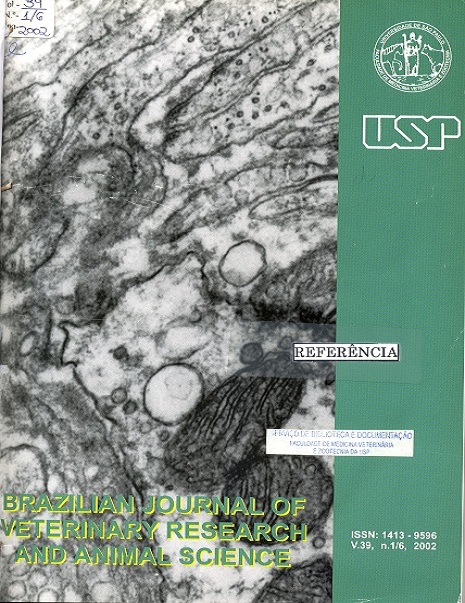Serum cortisol, lactate and creatinine concentrations in Thoroughbred fillies of different ages and states of training
DOI:
https://doi.org/10.1590/S1413-95962002000100010Keywords:
Hydrocortisone, Horses, Lactates, Creatinine, ExerciseAbstract
Exercise can be defined as "normal stress" stimulating body functions. Some reports suggest lactate as a stimulator of cortisol levels, while creatinine varies according to the amount of muscle tissue. In the present study we investigated the relationship between creatinine, serum lactate concentration and cortisol levels in training horses. Twenty-three Thoroughbred fillies were used, divided into 3 groups according to age and training protocol: G1, 1-2 years of age (N=7) on pasture, G2, 2-3 years (N=9) starting to be mounted, and G3, 3-4 years (N=7) racing at the Jockey Club. Blood samples were collected weekly during a six-month period at about 1:00 p.m. while the animals were resting. Cortisol was quantified with a commercial kit (Coat-a Count®) and serum creatinine and lactate were evaluated with an autoanalyzer with commercial reagents. Data were evaluated using non-parametric statistical tests, with the level of significance set at P< 0.05. Cortisol concentrations were 149ª + 7, 126b + 6, and 101c + 5 nmol/l, lactate concentrations were 2.1ª + 0.1, 2.0ª + 0.1, and 1.75b + 0.1 mmol/l, and creatinine concentrations were 125ª + 2, 132ª + 2 145b + 3 mumol/l in G1, G2 and G3, respectively. Only G2 showed a low but significant positive correlation of cortisol with lactate and a negative correlation of cortisol with creatinine levels. It was possible to conclude that cortisol, lactate and creatinine varied during horse aging and physical conditioning. The decrease of cortisol concentration (G2) suggests that the better physical condition acquired during training led to the increase of creatinine concentration, possibly related to muscle mass. The lower cortisol and lactate concentrations observed in G3 animals may have been due to greater muscle mass inducing an increase in creatinine concentrations or changes in muscle fiber type during training.Downloads
Download data is not yet available.
Downloads
Published
2002-01-01
Issue
Section
UNDEFINIED
License
The journal content is authorized under the Creative Commons BY-NC-SA license (summary of the license: https://
How to Cite
1.
Nogueira G de P, Barnabe RC, Bedran-de-Castro JC, Moreira AF, Fernandes WR, Mirandola RMS, et al. Serum cortisol, lactate and creatinine concentrations in Thoroughbred fillies of different ages and states of training. Braz. J. Vet. Res. Anim. Sci. [Internet]. 2002 Jan. 1 [cited 2026 Jan. 15];39(1):54-7. Available from: https://revistas.usp.br/bjvras/article/view/5940





